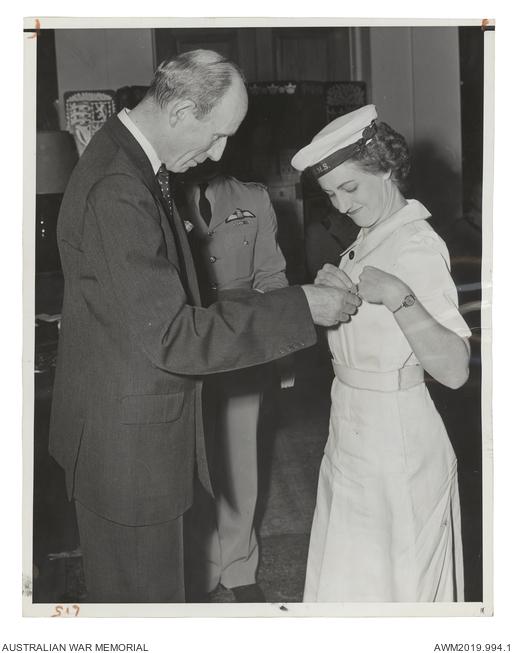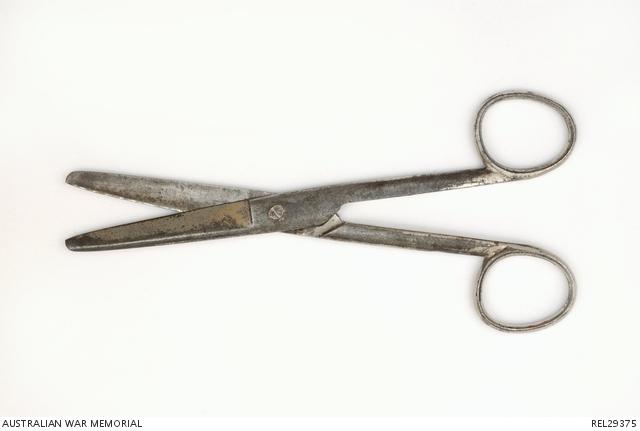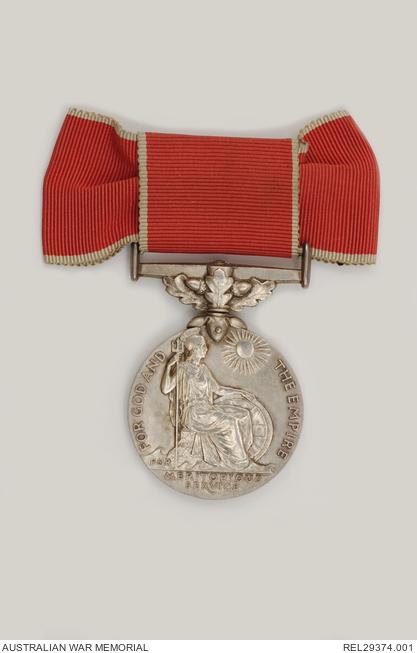“Exceptional qualities of fortitude and endurance": Margaret Gordon

Margaret Gordon receiving the British Empire Medal from Lord Halifax, 1944.
Travelling to the United Kingdom from India on board the passenger and cargo ship SS City of Cairo in 1942 were Australian Margaret Gordon and her Scottish husband, Crawford. They had both recently suffered from dengue fever. While Margaret recovered well, the doctors suggested that Gordon (as Margaret called her husband) travel to India to recover from post-sickness depression and a breakdown.
A month after the City of Cairo left Bombay, the ship departed Cape Town in South Africa, heading unescorted towards Brazil, before heading for her final destination of the United Kingdom. On 6 November at about 8.30 pm, a German torpedo struck the ship.
Margaret and Gordon were sitting in the lounge when the attack occurred. They returned to their cabin, collected their panic bags, warm clothing and torches. Margaret was in lifeboat 1, which had been lowered into the ocean. Gordon was following down a ladder when there was another explosion. Margaret’s lifeboat turned over and the passengers fell into the water.
Margaret never saw Gordon again. After being settled into the righted lifeboat, she looked for her husband and called out his name, but to no avail. She later found out that the men on the ladder had gone back on deck, where the captain ordered them to lifeboat 2. Gordon went down the ladder before Third Officer James Whyte, who thought Gordon had boarded the lifeboat.
Seeing lifeboat 2 drift over the ship’s well-deck, Whyte and another man swam away. The lifeboat was caught by the suction of the sinking ship and Gordon was believed to have gone down with it.
Margaret was later transferred to the smaller lifeboat 4. The day after the sinking, mothers and babies were transferred to lifeboat 5, the captain’s boat, leaving 19 men, women and children in lifeboat 4, including Whyte. That night, the boats were tied together and the first rations were issued.
The lifeboat’s rations included two kegs and two tanks of water, tins of hard tack biscuits, pemmican (a concentrated mixture of fat and protein), chocolate, and Horlicks milk tablets. Not knowing how long the journey to land would take, the water was strictly rationed, which made the dry food hard to eat.
A few days after the sinking the lifeboat was taking on water, so it was decided to lighten it. The women and children were moved to other boats, but conditions were too rough when except for Margaret was to be transferred. She tried to keep up morale by encouraging the men to brush their teeth with her toothbrush; the group tidied themselves up with a comb owned by one of the men.
It was a struggle to keep the six lifeboats together. They were of different sizes and only one had a sextant for navigation, although the other boats had compasses and watches. At night they tied themselves together or tried to keep in contact using torches and lanterns. The night the ship had sunk, a U-boat came alongside one of the lifeboats to ask the name of the ship, cargo and whether there were German prisoners on board. The inquirer gave the survivors advice on the location of the nearest land masses – Africa, South America and the tiny island of St Helena – before leaving, saying “Goodnight, and sorry for sinking you”. The boats would separate and meet up at different times. They could not return to Africa due to the wind, and Brazil was thousands of miles away, so the captain decided to aim for St Helena, about 500 miles from where the ship sank.
After a week at sea, Margaret felt Whyte needed another man to help steer the boat and swapped places with a man from lifeboat 8, a larger lifeboat with about 60 people on board. Conditions were crowded. She observed how another passenger, Marjorie Miller, looked after the welfare of everyone on the lifeboat, including managing rations, maintaining general fitness, and caring for illness and injuries. With nothing to do to help, Margaret began to feel she let Whyte down by leaving the lifeboat. After getting advice from Marjorie on caring for the other occupants, she returned to lifeboat 4.
Lifeboats 4 and 8 had managed to stay together, but there was concern that lifeboat 8 was holding lifeboat 4 back, and it was decided that the smaller boat would continue on ahead.

Pair of scissors from the first aid kit of lifeboat 4 (REL29375)
On her return to lifeboat 4 Margaret tried to improve the situation of those on the ship. She trailed clothes over the side to wash them and hung them to dry; made hats and moccasins from the canvas sails cover; massaged legs with whale oil; and used cold cream from her panic bag to treat sunburn.
On 18 November, two days after separating from lifeboat 8, an Indian sailor died. Over the next week his death was followed by the deaths of the other nine Indians on board.
On 20 November, Whyte thought they may be near St Helena, but they did not sight land. The next day Whyte called the survivors together to vote on what to do. Their chances of finding the island were slim, so he suggested trying to head for South America. They voted for the latter but this decision seemed to affect morale. On 25 November, Freddie Powell, who had swapped with Margaret from lifeboat 8, and then remained when she returned, died from delirium after drinking salt water. Three days later another man died, followed by another almost a week later. This left four survivors, two of whom were in poor condition. Only Whyte and Margaret were in any condition to sail the boat.
Through December they sailed day and night with three-hour watches at night and shorter ones in the heat of the day. By this point their eyesight was poor and they were both slightly deaf. On 18 December there was another death, followed by another two days later. Only Margaret and Whyte remained alive.
On Christmas Day they drank the last of the brandy. They saw a sea plane that afternoon and dropped a flare overboard, but by the time it went off the aircraft had passed. On 27 December it rained for the first time of their journey, and they filled their tanks. Later that morning Margaret woke to Whyte crying out “Ships! Ships!” He had spotted a convoy. Knocker dropped their flares into the water, only the last of which worked, and the smoke was sighted.
A ship came towards them and Margaret and Whyte collected their belongings. On board the Brazilian minesweeper Caravelas they were each given a huge mug of coffee.
If Margaret had stayed on lifeboat 8, she would have been rescued by SS Bendoran on 19 November. Lifeboats 5, 6 and 7 were rescued by SS Clan Alpine that same day. Lifeboat 1 was rescued on 12 December by the German blockade runner Rhakotis, but by then there were only three survivors – 51 other passengers had died. One of the three who were rescued died during surgery on the German ship. The two survivors of lifeboat 1 endured another sinking – the Rhakotis was sunk by a British vessel – but both survived.
Margaret spent three months in Brazil before being convinced to set sail again, this time for America, but she refused to travel by ship again until war’s end. Whyte had flown to America in January and after recovering left for England as a “distressed British seaman” aboard SS City of Pretoria in late February. The ship vanished during the journey and it was later discovered that she had been sunk by U-172 on 4 March 1943 with all hands lost. Many of the items saved from lifeoat 4 were lost with Whyte.

The British Empire Medal awarded to Margaret Gordon in 1944.
Margaret lived with an aunt in America and worked as a librarian at the office of the Australian Trade Commissioner in New York. She joined the Women’s Royal Naval Service, serving in Washington and London. In 1944 she was awarded the British Empire Medal by the British Ambassador to America, Lord Halifax, for her work in the lifeboat. Her recommendation reads: “Mrs Gordon showed exceptional qualities of fortitude and endurance. When the occupants of the boat died one after another, she did all in her power to allay their sufferings. Towards the end of the voyage she kept watch with the Third Officer in sailing and steering the boat.”
She returned to Australia after the war, remarried and, after her husband’s death in 1959, became a well-respected children’s librarian, establishing the Children’s Literature Collection at the State Library of Victoria. Margaret died in 1999.
Further reading:
Goodnight, sorry for sinking you: the story of the S.S. City of Cairo / Ralph Barker
SS City of Cairo website - http://www.sscityofcairo.co.uk/